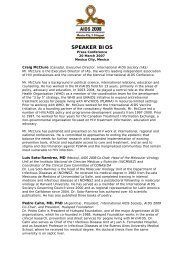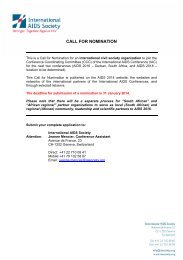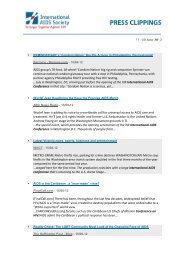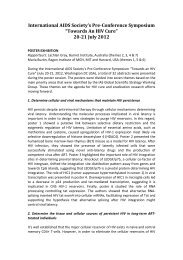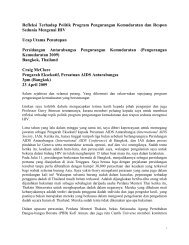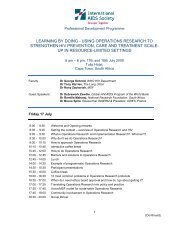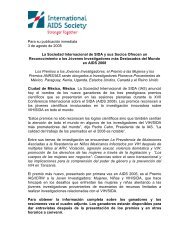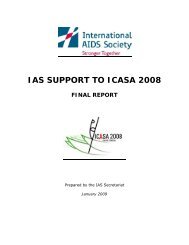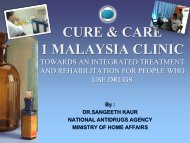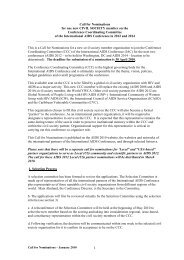Advocacy in Action - International AIDS Society
Advocacy in Action - International AIDS Society
Advocacy in Action - International AIDS Society
You also want an ePaper? Increase the reach of your titles
YUMPU automatically turns print PDFs into web optimized ePapers that Google loves.
<strong>Advocacy</strong> <strong>in</strong> <strong>Action</strong> Card 3<br />
Work<strong>in</strong>g from <strong>in</strong>side the system<br />
INFORMATION<br />
CARD<br />
Introduction<br />
One of the most effective steps for <strong>in</strong>fluenc<strong>in</strong>g change is to work from ‘<strong>in</strong>side the system’ – by<br />
participat<strong>in</strong>g <strong>in</strong> decision-mak<strong>in</strong>g bodies. This can be very useful, but it is not easy. There is a<br />
danger of be<strong>in</strong>g used as a ‘token’ representative.<br />
Decisions affect<strong>in</strong>g your advocacy issue or problem are made <strong>in</strong> many different fora, i.e., local<br />
council committees, sub-committees and work<strong>in</strong>g groups, jo<strong>in</strong>t committees between different<br />
public services (for example, health and education, advisory committees to government<br />
m<strong>in</strong>istries), trade associations, company boardrooms, trade unions, committees of religious<br />
leaders, school boards of governors, district health committees, employment tribunals, social<br />
welfare committees – and many more.<br />
It is important to know how and where the decisions are made. The next step is to learn how<br />
people can take a seat at the table <strong>in</strong> these meet<strong>in</strong>gs and to <strong>in</strong>fluence their decisions. Are<br />
representatives elected, selected or co-opted?<br />
It is also important to take full advantage of any official positions already enjoyed by members<br />
of your organisation or coalition.<br />
A representative needs to be well prepared, focused and supported by those who you<br />
represent and are accountable to.<br />
<strong>Advocacy</strong> <strong>in</strong> <strong>Action</strong> Card 3 Work<strong>in</strong>g from <strong>in</strong>side the system<br />
Advantages<br />
✔ You can <strong>in</strong>fluence decisions <strong>in</strong> a<br />
susta<strong>in</strong>ed, long-term way.<br />
✔ It is often easier to have an <strong>in</strong>fluence<br />
‘<strong>in</strong>side the system’ than outside it.<br />
✔ You can ga<strong>in</strong> access to more<br />
<strong>in</strong>formation, to see realistic was to<br />
<strong>in</strong>fluence change.<br />
✔ It is a great opportunity to build<br />
relationships with decision-makers<br />
✔ Your organisation can ga<strong>in</strong> more<br />
respect and credibility.<br />
Disadvantages<br />
✘ Some decision-mak<strong>in</strong>g bodies are not<br />
open to change.<br />
✘ You may feel isolated.<br />
✘ You will be associated with decisions<br />
with which you may disagree.<br />
✘ The decision-mak<strong>in</strong>g body may have<br />
different values to the values of your<br />
organisation.<br />
✘ You may be encouraged to identify more<br />
with the decision-makers than with the<br />
people you represent.




